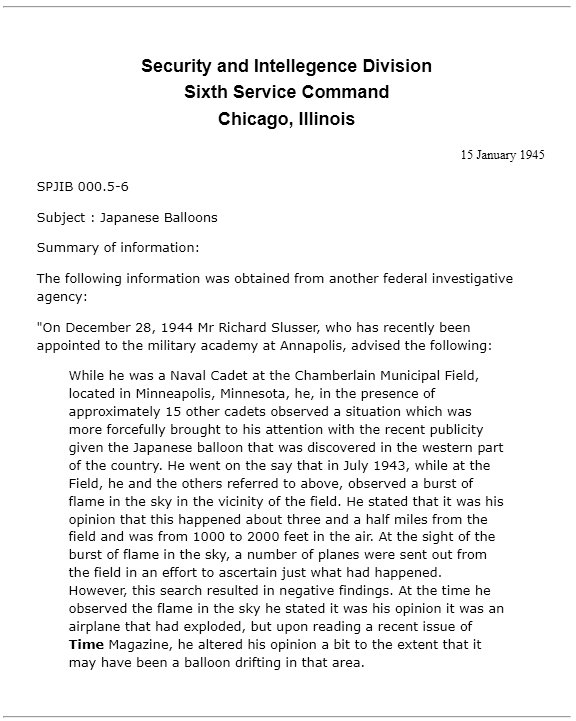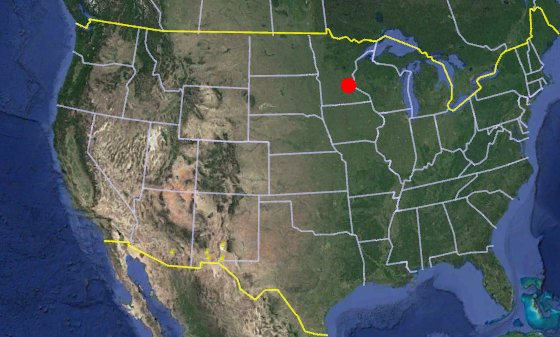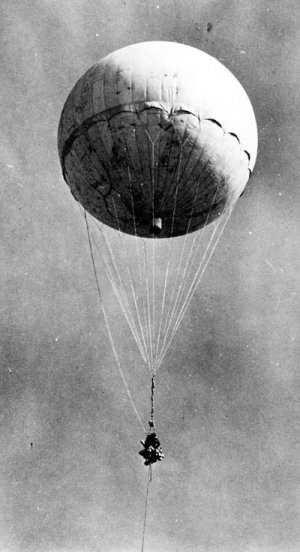ACUFO-1943-07-00-MINNEAPOLIS-1
The American ufologist Jan Aldrich found a Security and Intelligence Division report by the Sixth Service Command, Chicago, Illinois, USA, dated January 15, 1945, about “Japanese Balloons”.
It said that the following information was obtained from “another federal investigative agency”:
“On December 28, 1944 Mr. Richard Slusser, who has recently been appointed to the military academy at Annapolis, advised the following:
“While he was a Naval Cadet at the Chamberlain Municipal Field, located in Minneapolis, Minnesota, he, in the presence of approximately 15 other cadets observed a situation which was more forcefully brought to his attention with the recent publicity given the Japanese balloon that was discovered in the western part of the country. He went on the say that in July 1943, while at the Field, he and the others referred to above, observed a burst of flame in the sky in the vicinity of the field. He stated that it was his opinion that this happened about three and a half miles from the field and was from 1000 to 2000 feet in the air. At the sight of the burst of flame in the sky, a number of planes were sent out from the field in an effort to ascertain just what had happened. However, this search resulted in negative findings. At the time he observed the flame in the sky he stated it was his opinion it was an airplane that had exploded, but upon reading a recent issue of Time Magazine, he altered his opinion a bit to the extent that it may have been a balloon drifting in that area.”
| Date: | July 1943 |
|---|---|
| Time: | ? |
| Duration: | ? |
| First known report date: | 1945 |
| Reporting delay: | Day, 2 years. |
| Country: | USA |
|---|---|
| State/Department: | Minnesota |
| City or place: | Minneapolis |
| Number of alleged witnesses: | 15 |
|---|---|
| Number of known witnesses: | 1 |
| Number of named witnesses: | 1 |
| Reporting channel: | Unknown official US Agency. |
|---|---|
| Visibility conditions: | ? |
| UFO observed: | Yes. |
| UFO arrival observed: | ? |
| UFO departure observed: | Yes. |
| UFO action: | Exploded. |
| Witnesses action: | Sent planes to investigate, in vain. |
| Photographs: | No. |
| Sketch(s) by witness(es): | No. |
| Sketch(es) approved by witness(es): | No. |
| Witness(es) feelings: | ? |
| Witnesses interpretation: | Plane on fire, then Japanese fire balloon. |
| Sensors: |
[X] Visual: 15.
[ ] Airborne radar: [ ] Directional ground radar: [ ] Height finder ground radar: [ ] Photo: [ ] Film/video: [ ] EM Effects: [ ] Failures: [ ] Damages: |
|---|---|
| Hynek: | ? |
| Armed / unarmed: | ? |
| Reliability 1-3: | 3 |
| Strangeness 1-3: | 1 |
| ACUFO: | Possible meteor. |
[Ref. prt1:] JAN ALDRICH - "PROJECT 1947":

|
Security and Intelligence Division
Sixth Service Command
Chicago, Illinois
15 January 1945
SPJIB 000.5-6
Subject: Japanese Balloons
Summary of information:
The following information was obtained from another federal investigative agency:
“On December 28, 1944 Mr. Richard Slusser, who has recently been appointed to the military academy at Annapolis, advised the following:
While he was a Naval Cadet at the Chamberlain Municipal Field, located in Minneapolis, Minnesota, he, in the presence of approximately 15 other cadets observed a situation which was more forcefully brought to his attention with the recent publicity given the Japanese balloon that was discovered in the western part of the country. He went on the say that in July 1943, while at the Field, he and the others referred to above, observed a burst of flame in the sky in the vicinity of the field. He stated that it was his opinion that this happened about three and a half miles from the field and was from 1000 to 2000 feet in the air. At the sight of the burst of flame in the sky, a number of planes were sent out from the field in an effort to ascertain just what had happened. However, this search resulted in negative findings. At the time he observed the flame in the sky he stated it was his opinion it was an airplane that had exploded, but upon reading a recent issue of Time Magazine, he altered his opinion a bit to the extent that it may have been a balloon drifting in that area.
No information is known about the planes involved.

|
Richard Cowden Slusser (1925 - 2001) retired from the US Navy in 1976 with the rank of Captain.
Between November 1944 and April 1945, the Japanese Army launched about 9300 balloons from sites on the coast of Honshu, which drifted with the high-altitude air currents, today known as the jet stream, intended to travel to the United States and set large-scale forest fires and spread panic with incendiary bombs.

|
The Fugo balloons (photo above) were hydrogen-filled paper balloon about 10 meters in diameter, the payload was four 11-pound (5.0 kg) incendiary devices and one 33-pound (15 kg) high-explosive anti-personnel bomb.
About 300 Fugo balloons were found or observed in the U.S., Canada, and Mexico; but they were largely ineffective as fire starters due to damp seasonal conditions, with no forest fires being attributed to the offensive. A U.S. media censorship campaign prevented the Japanese Army from learning of the offensive's results.
The only fatalities they caused were on May 5, 1945, when six civilians were killed by one of the bombs near Bly, Oregon, USA.
The case in Minneapolis would seem easily solved at first glance; but there is a problem of date: the first tests of the Fugo balloons took place only in September 1944. And the first operational launch did not take place until November 3, 1944 - this was to take advantage of the correct orientation of the jet streams in winter.
However, another ordinary explanation is possible: maybe it was a meteor.
Possible meteor.
* = Source is available to me.
? = Source I am told about but could not get so far. Help needed.
| Main author: | Patrick Gross |
|---|---|
| Contributors: | None |
| Reviewers: | None |
| Editor: | Patrick Gross |
| Version: | Create/changed by: | Date: | Description: |
|---|---|---|---|
| 0.1 | Patrick Gross | December 28, 2023 | Creation, [prt1]. |
| 1.0 | Patrick Gross | December 28, 2023 | First published. |